Lagrima (prelude 20) by Francisco Tarrega (1852-1909)
Grade 4 Late Intermediate
 Tárrega is considered to have laid the foundations for 20th century classical guitar and for increasing interest in the guitar as a recital instrument. Tárrega preferred small intimate performances over the concert stage. Some believe this was because he played without the nails needed for volume. Others say this was related to his childhood trauma. |



Notes
Exercise: Rubato, Varied Tempo.
One of Tarrega most popular and beautiful piece. “Lagrima” means “teardrop”. A deft piece using the whole neck and 4 fingers on the right hand.
Guitar Demo (Rafael Elizondo)
Guitar Pro Playthrough
Since the song is slow, suspend to the notes as long as possible, no staccato or disjointed notes.
Being a “Romantic” piece, Lagrima also lends itself to some degree of Rubato, especially in the second E minor section. Rubato literally means “robbed”. It is a slight slowing, then quickening of the tempo and if done properly can make a piece seem so more musical. If you played Lagrima as just black and white notes in perfect timing it would lose all of its “soul” and become dull and lifeless.
The hardest part is bar 6,7 and bar 10. While bar 6,7 deals with rapid chord changes on the left hand, bar 10 deals with rapid 2 finger (im) plucking on the right hand. My tab provides the fingerings best for me. Feel free to explore chord alternatives and different fingering if it works better for you.
Taken From Spanish For Guitar by Howard Wallach.
